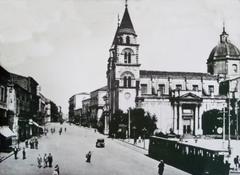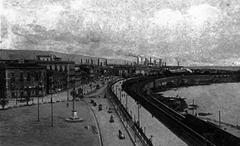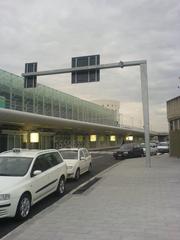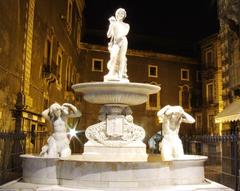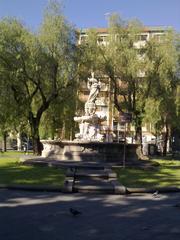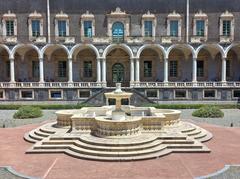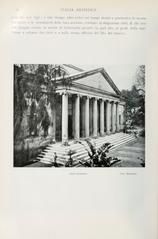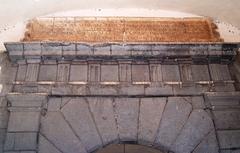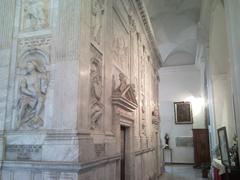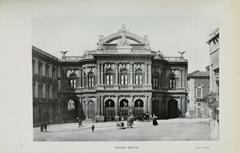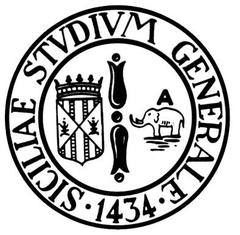
Comprehensive Guide to Visiting Catania, Metropolitan City of Catania, Italy
Date: 13/08/2024
Captivating Introduction
Welcome to Catania, an enchanting city where the ancient and the contemporary dance in perfect harmony beneath the ever-watchful eye of Mount Etna. Imagine strolling through a labyrinth of cobblestone streets, the scent of citrus and fresh seafood tantalizing your senses, while Baroque facades bathed in golden sunlight whisper tales of resilience and rebirth (Britannica). Founded by Chalcidian Greeks in the 8th century BC, Catania has been a coveted jewel, enticing Romans, Byzantines, Arabs, and Normans to leave their indelible marks on its culture and landscape (Wikipedia).
But Catania is not just a city of the past. Its vibrant markets, lively festivals, and modern economic heartbeat make it a thrilling destination for any traveler. Picture yourself sipping an espresso in Piazza del Duomo, where the quirky Elephant Fountain stands as a testament to the city’s indomitable spirit, or hiking the trails of Mount Etna, Europe’s tallest active volcano, with panoramic views that take your breath away (PlanetWare).
As you explore Catania, you’ll discover hidden gems like Via Crociferi, a Baroque street perfect for an evening stroll, or the eerie yet fascinating lava caves of Mount Etna. Engage all your senses in the bustling La Pescheria fish market, where the calls of vendors and the aroma of fresh seafood create a sensory symphony. Whether you’re a history buff, a foodie, or an adventurer, Catania offers a rich tapestry of experiences that promise to captivate and delight (Savoring Italy).
Prepare to delve into the heart of Catania, where every corner holds a story, and every story beckons you to become a part of it. Let’s embark on this journey together, uncovering the secrets and wonders of a city that refuses to be forgotten.
Table of Contents
- [History and Significance of Catania](#history-and-significance-of-cataniahistory-and-significance-of-catania)
- [Ancient Origins and Greek Influence](#ancient-origins-and-greek-influenceancient-origins-and-greek-influence)
- [Roman Era](#roman-eraroman-era)
- [Byzantine, Arab, and Norman Conquests](#byzantine-arab-and-norman-conquestsbyzantine-arab-and-norman-conquests)
- [The Renaissance and Cultural Flourishing](#the-renaissance-and-cultural-flourishingthe-renaissance-and-cultural-flourishing)
- [Natural Disasters and Reconstruction](#natural-disasters-and-reconstructionnatural-disasters-and-reconstruction)
- [Modern Era and Economic Development](#modern-era-and-economic-developmentmodern-era-and-economic-development)
- [Cultural Significance and UNESCO Recognition](#cultural-significance-and-unesco-recognitioncultural-significance-and-unesco-recognition)
- [Resilience and Modern Identity](#resilience-and-modern-identityresilience-and-modern-identity)
- [Top Attractions in Catania](#top-attractions-in-cataniatop-attractions-in-catania)
- [Piazza del Duomo and the Elephant Fountain](#piazza-del-duomo-and-the-elephant-fountainpiazza-del-duomo-and-the-elephant-fountain)
- [Catania Cathedral (Basilica Cattedrale Sant’Agata)](#catania-cathedral-basilica-cattedrale-santagatacatania-cathedral-basilica-cattedrale-santagata)
- [Roman Amphitheater](#roman-amphitheaterroman-amphitheater)
- [Hidden Gem: Via Crociferi](#hidden-gem-via-crociferihidden-gem-via-crociferi)
- [Castello Ursino](#castello-ursinocastello-ursino)
- [Monastero dei Benedettini](#monastero-dei-benedettinimonastero-dei-benedettini)
- [Teatro Massimo Bellini](#teatro-massimo-belliniteatro-massimo-bellini)
- [Mount Etna](#mount-etnamount-etna)
- [Local Secret: Hidden Caves of Etna](#local-secret-hidden-caves-of-etnalocal-secret-hidden-caves-of-etna)
- [La Pescheria (Fish Market)](#la-pescheria-fish-marketla-pescheria-fish-market)
- [Via Etnea](#via-etneavia-etnea)
- [Giardino Bellini](#giardino-bellinigiardino-bellini)
- [Palazzo Biscari](#palazzo-biscaripalazzo-biscari)
- [Museo Storico dello Sbarco in Sicilia 1943](#museo-storico-dello-sbarco-in-sicilia-1943museo-storico-dello-sbarco-in-sicilia-1943)
- [Teatro Romano](#teatro-romanoteatro-romano)
- [Day Trip to Taormina](#day-trip-to-taorminaday-trip-to-taormina)
- [Etna National Park](#etna-national-parketna-national-park)
- [Villa Bellini](#villa-bellinivilla-bellini)
- [Museo Civico Castello Ursino](#museo-civico-castello-ursinomuseo-civico-castello-ursino)
- [Piazza Stesicoro](#piazza-stesicoropiazza-stesicoro)
- [Church of San Nicolò l’Arena](#church-of-san-nicolò-larenachurch-of-san-nicolò-larena)
- [Aci Castello](#aci-castelloaci-castello)
- [Conclusion: Unveil Catania with Audiala](#conclusion-unveil-catania-with-audialaconclusion-unveil-catania-with-audiala)
- [Visitor Tips and Practical Information](#visitor-tips-and-practical-informationvisitor-tips-and-practical-information)
- [Introduction](#introductionintroduction)
- [Getting to Catania](#getting-to-cataniagetting-to-catania)
- [Getting Around Catania](#getting-around-cataniagetting-around-catania)
- [Walking](#walkingwalking)
- [Public Transport](#public-transportpublic-transport)
- [Taxis](#taxistaxis)
- [Accommodation](#accommodationaccommodation)
- [Dining and Cuisine](#dining-and-cuisinedining-and-cuisine)
- [Attractions](#attractionsattractions)
- [Mount Etna](#mount-etnamount-etna)
- [Cathedral of Saint Agatha](#cathedral-of-saint-agathacathedral-of-saint-agatha)
- [Ursino Castle](#ursino-castleursino-castle)
- [Botanical Garden: Orto Botanico dell’Università di Catania](#botanical-garden-orto-botanico-delluniversità-di-cataniabotanical-garden-orto-botanico-delluniversità-di-catania)
- [Festivals and Events](#festivals-and-eventsfestivals-and-events)
- [Feast of Saint Agatha](#feast-of-saint-agathafeast-of-saint-agatha)
- [Practical Tips](#practical-tipspractical-tips)
- [Language](#languagelanguage)
- [Currency](#currencycurrency)
- [Safety](#safetysafety)
- [Health and Travel Insurance](#health-and-travel-insurancehealth-and-travel-insurance)
- [Budgeting](#budgetingbudgeting)
- [Daily Expenses](#daily-expensesdaily-expenses)
- [Parking](#parkingparking)
- [Street Parking](#street-parkingstreet-parking)
- [Parking Garages](#parking-garagesparking-garages)
- [Additional Tips](#additional-tipsadditional-tips)
- [Best Time to Visit](#best-time-to-visitbest-time-to-visit)
- [Local Etiquette](#local-etiquettelocal-etiquette)
- [Call to Action](#call-to-actioncall-to-action)
History and Significance of Catania
Ancient Origins and Greek Influence
Catania’s history dates back to the 8th century BC when it was founded by Chalcidian Greeks from Naxos. This early Greek colony thrived on fertile lands with the Ionian Sea as its backdrop (Britannica).
Roman Era
In 263 BC, Catania welcomed the Romans and became a significant city under their rule. Emperor Augustus even made it a colony, transforming it with bustling markets, aqueducts, and extensive roads (Britannica).
Byzantine, Arab, and Norman Conquests
Catania saw a series of conquests, with the Byzantines, Arabs, and Normans each leaving their mark. The Arabs introduced new crops and farming techniques, enhancing the local economy, while the Normans in the 11th century built architectural icons like the Ursino Castle (Wikipedia).
The Renaissance and Cultural Flourishing
In the 14th century, Catania flourished during the Renaissance, founding Sicily’s first university in 1434. This period saw the rise of cultural figures like Vincenzo Bellini and Giovanni Verga, making Catania a beacon of learning and culture (Wikipedia).
Natural Disasters and Reconstruction
Catania faced significant natural disasters, including earthquakes in 1169 and 1693, and a devastating eruption from Mount Etna in 1669. The city was rebuilt in the Baroque style by architect Giovanni Battista Vaccarini, earning its historic center a UNESCO World Heritage Site designation (Wikipedia, PlanetWare).
Modern Era and Economic Development
In the 19th century, Catania played a crucial role in the movement for Sicilian autonomy, leading to Italy’s unification in 1861. The 20th century saw further challenges with eruptions from Mount Etna, but today, Catania thrives as Sicily’s industrial and commercial hub, with the Catania–Fontanarossa Airport boosting economic activity and tourism (Wikipedia).
Cultural Significance and UNESCO Recognition
Catania’s cultural heritage is vibrant, with must-see sites like Piazza del Duomo, the Roman Amphitheater, and Castello Ursino. The city’s Baroque architecture, much of it designed by Vaccarini, is a major draw for tourists (Savoring Italy, High Heels and a Backpack, PlanetWare).
Resilience and Modern Identity
Living under the shadow of Mount Etna has instilled a unique zest for life among the residents of Catania. This spirit is evident in the city’s lively markets and festivals, particularly the Feast of Saint Agatha in February, which features processions, fireworks, and religious ceremonies (Go Ask a Local).
Top Attractions in Catania
Piazza del Duomo and the Elephant Fountain
At the heart of Catania lies Piazza del Duomo, a lively square that’s a feast for the senses and a UNESCO World Heritage Site. Here, you’ll find the quirky Elephant Fountain (Fontana dell’Elefante), designed by Giovanni Battista Vaccarini. This ancient lava stone elephant, affectionately known as “u Liotru,” is said to protect the city from Mount Etna’s fiery temper (Wikipedia).
Catania Cathedral (Basilica Cattedrale Sant’Agata)
Adjacent to the Piazza del Duomo stands the Catania Cathedral, dedicated to Saint Agatha, the city’s patron saint. The cathedral’s dramatic history of destruction and rebirth mirrors the resilience of Catania itself. Inside, you’ll find the relics of Saint Agatha and the tomb of composer Vincenzo Bellini (PlanetWare).
Roman Amphitheater
Just a stone’s throw from modern Catania, the Roman Amphitheater, built in the 2nd century AD, offers a portal to the past. Imagine the roars of 16,000 spectators echoing through the centuries as you wander its remains. Partial ruins peek out from under the city, a testament to Catania’s layers of history waiting to be uncovered (My Global Viewpoint).
Hidden Gem: Via Crociferi
Take a detour to Via Crociferi, a lesser-known street that’s an architectural marvel. This Baroque street is perfect for an evening stroll, with stunning churches and cloisters bathed in the golden glow of sunset.
Castello Ursino
Built in the 13th century by Emperor Frederick II, Castello Ursino is one of the few structures that survived the 1693 earthquake. Today, it houses the Museo Civico, showcasing artifacts from ancient Greek and Roman times to the Middle Ages. The castle’s robust architecture and captivating history make it a must-visit. Pro tip: Visit during the evening for a breathtaking view of the city lights (The Crazy Tourist).
Monastero dei Benedettini
The Monastero dei Benedettini is a sprawling Benedictine monastery and a UNESCO World Heritage Site. Founded in the 16th century, this architectural marvel now forms part of the University of Catania. A guided tour reveals its cloisters, gardens, and historical rooms (My Global Viewpoint).
Teatro Massimo Bellini
Named after Catania’s own Vincenzo Bellini, Teatro Massimo Bellini is an opera house straight out of a dream. Opened in 1890, its Renaissance and Baroque architecture, coupled with golden interiors, make it a visual and auditory feast. Attend an opera or take a tour to feel like a 19th-century aristocrat (My Global Viewpoint).
Mount Etna
For the adventurers, Mount Etna awaits. Europe’s tallest active volcano offers hiking, cycling, and guided tours. On clear days, the summit provides breathtaking views of Sicily and the Ionian Sea. Feeling daring? Try a night hike to see the lava flows glow under the stars (The Crazy Tourist).
Local Secret: Hidden Caves of Etna
Not many know about the hidden caves formed by Mount Etna’s ancient lava flows. Join a guided tour to explore these eerie, yet fascinating, underground labyrinths.
La Pescheria (Fish Market)
La Pescheria, near Piazza del Duomo, is Catania’s vibrant fish market. It’s a sensory overload: the calls of vendors, the aroma of fresh seafood, and the colorful displays of fruits and vegetables. Sample traditional Sicilian street food like arancini and fresh seafood dishes (Savoring Italy).
Via Etnea
Stroll down Via Etnea, Catania’s main shopping street, which stretches from Piazza del Duomo to the foothills of Mount Etna. Lined with shops, cafes, and historic buildings, it’s perfect for a leisurely walk. Pro tip: Grab a gelato and enjoy the stunning views of Mount Etna as you wander (PlanetWare).
Giardino Bellini
Giardino Bellini is the city’s oldest urban park, offering a peaceful retreat. Wander through beautifully landscaped gardens, fountains, and statues. Bring a picnic and relax, or catch one of the many cultural events hosted here throughout the year (Voyage Tips).
Palazzo Biscari
Step into opulence at Palazzo Biscari, a Baroque palace still owned by the Biscari family. Take a guided tour to marvel at its grand ballroom and frescoed ceilings. It’s like stepping into a time capsule of aristocratic life (PlanetWare).
Museo Storico dello Sbarco in Sicilia 1943
This museum commemorates the Allied invasion of Sicily during World War II. Through artifacts, photographs, and interactive displays, it offers a moving account of the invasion’s impact. It’s a poignant reminder of the resilience and courage of the local people (The Crazy Tourist).
Teatro Romano
The Teatro Romano, dating back to the 2nd century AD, is another gem in Catania’s rich historical tapestry. It once held around 7,000 spectators. Explore this ancient site and imagine the echoes of Roman performances. Nearby, the Odeon, a smaller theater, offers a glimpse into musical performances of the past (My Global Viewpoint).
Day Trip to Taormina
An hour’s drive from Catania, Taormina is a picturesque town perched on a mountaintop. It offers stunning views of the Ionian Sea and Mount Etna. Key attractions include the ancient Greek theater (Teatro Greco) and the beautiful beaches of Isola Bella. Pack a camera—this spot is Instagram gold (High Heels and a Backpack).
Etna National Park
Etna National Park, encompassing Mount Etna and its surroundings, is a UNESCO World Heritage Site. It offers hiking trails, guided tours, and unique volcanic landscapes. Nature lovers and adventure enthusiasts will find paradise here (Savoring Italy).
Villa Bellini
Another gem of a park, Villa Bellini is known for its lush gardens and panoramic views of the city and Mount Etna. It’s a popular spot for both locals and tourists, offering a serene environment for relaxation and recreation (Voyage Tips).
Museo Civico Castello Ursino
Housed inside Castello Ursino, the Museo Civico features a collection that spans ancient Greek and Roman sculptures to Renaissance paintings. It’s a treasure trove of Catania’s rich history and cultural heritage (The Crazy Tourist).
Piazza Stesicoro
Piazza Stesicoro is a vibrant square known for its historical significance and lively atmosphere. The square is home to the ruins of the Roman Amphitheater and a monument to Vincenzo Bellini. It’s the perfect place to soak in the city’s energy and explore nearby shops and cafes (Voyage Tips).
Church of San Nicolò l’Arena
The Church of San Nicolò l’A### Church of San Nicolò l’Arena The Church of San Nicolò l’Arena is one of Sicily’s largest churches. Built in the 16th century, it features a mix of Baroque and Neoclassical styles. Its unfinished facade and massive interior make it a unique and intriguing visit (PlanetWare).
Aci Castello
Aci Castello, just north of Catania, is famous for its Norman castle built on a rocky outcrop overlooking the sea. The 11th-century castle now houses a museum with exhibits on local history and marine biology. Its picturesque setting and historical charm make it a perfect day trip (The Crazy Tourist).
Conclusion: Unveil Catania with Audiala
Catania is a city that blends history, culture, and natural beauty into a vibrant tapestry. From ancient ruins and Baroque architecture to the shadow of Mount Etna, there’s something for every traveler. Ready to uncover Catania’s secrets? Download Audiala, your ultimate tour guide app, to enhance your exploration with expertly crafted audio guides that reveal the city’s secrets and stories. Let Audiala be your companion as you delve into the heart of Catania, ensuring that your journey is as unforgettable as the city itself. Don’t miss out—download Audiala and let the adventure begin!
Visitor Tips and Practical Information for Catania, Metropolitan City of Catania, Italy
Introduction
Welcome to Catania, the fiery heart of Sicily where ancient history and modern vibrancy collide at the foot of Europe’s most active volcano, Mount Etna. Imagine the scent of citrus in the air, the sound of church bells ringing, and the sight of Baroque architecture bathed in the golden Mediterranean sun. Intrigued? Let’s dive into the secrets of Catania!
Getting to Catania
By Air
Fly into Catania Fontanarossa Airport, just 20 minutes from the city center—a hop, skip, and a jump from your Sicilian adventure! For flight details, visit the Catania Fontanarossa Airport website.
By Train
Traveling by train? Catania Centrale is your gateway. Whether you’re coming from Palermo (4 hours) or Taormina (1 hour), Trenitalia has you covered. Check schedules on Trenitalia.
By Car
Renting a car? Great for exploring but beware of the ZTL zones in the old center. Park outside and stroll through Catania’s charming streets. For rentals, browse Sunny Cars.
Getting Around Catania
Walking
Catania is a walker’s paradise. Wander through its historic center, where cobblestone streets lead you to hidden gems and local delights.
Public Transport
AMT Catania buses can take you where your feet can’t. For routes and schedules, visit the AMT Catania website.
Taxis
Need a quick ride? Taxis are your friend, especially to/from the airport (about €30). Reliable services can be found at Sicily Transfer Taxi.
Accommodation
Stay close to the action! The old piazza area offers everything from luxury hotels to budget-friendly B&Bs. For recommendations, visit Salt in our Hair.
Dining and Cuisine
Catania’s culinary scene is a feast for the senses. Visit the Catania Fish Market near Piazza del Duomo for seafood so fresh it practically swims onto your plate. For more dining tips, check Traveling Italian.
Attractions
Mount Etna
Hike the trails of Etna Park, explore lava caves, and soak in the stunning views. For guided tours, visit Visit Sicily.
Cathedral of Saint Agatha
This Baroque masterpiece in Piazza del Duomo is a tribute to Catania’s patron saint. More info at Salt in our Hair.
Ursino Castle
Step back in time at this 13th-century fortress, now a museum of historical artifacts. Explore more at Salt in our Hair.
Botanical Garden: Orto Botanico dell’Università di Catania
Escape the city bustle amidst lush greenery and regional flora. Details at Salt in our Hair.
Festivals and Events
Feast of Saint Agatha
Join the vibrant celebrations from February 3rd to 5th, honoring Saint Agatha with processions, fireworks, and more. Learn more at Visit Sicily.
Practical Tips
Language
Italian is king, but English is widely spoken in tourist spots. Brush up on basics like “Buongiorno” (Good morning) to charm the locals.
Currency
Carry Euros (€) and a bit of cash for small purchases. Most places accept credit cards.
Safety
Catania is generally safe but stay vigilant. Keep an eye on your belongings in crowded areas and avoid poorly lit streets at night.
Health and Travel Insurance
Travel insurance is a must. Check out Heymondo for comprehensive coverage.
Budgeting
Daily Expenses
Budget around €260 per day for a comfortable stay. For detailed budgeting tips, visit Traveling Italian.
Parking
Street Parking
Look for blue lines (paid parking) and white lines (resident-only). Display your ticket prominently. More tips at Traveling Italian.
Parking Garages
Safer and convenient. Search “Parcheggio” on Google Maps near your destination. Some hotels offer parking too.
Additional Tips
Best Time to Visit
Spring (April to June) and fall (September to October) offer mild weather and fewer crowds.
Local Etiquette
Sicilians are hospitable folks. Greet with “Buongiorno” or “Buonasera”. Tipping isn’t mandatory but rounding up the bill is appreciated.
Call to Action
Ready to unlock the secrets of Catania? Download Audiala, your ultimate tour guide app, for expertly crafted audio guides that reveal the city’s hidden gems. Let Audiala be your companion on this unforgettable adventure!
For more detailed information and tips on visiting Catania, check out Salt in our Hair and Visit Sicily.

